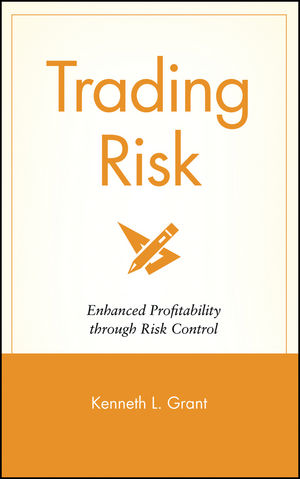Trading Risk: Enhanced Profitability through Risk ControlISBN: 978-0-471-65091-1
Hardcover
272 pages
September 2004
 This is a Print-on-Demand title. It will be printed specifically to fill your order. Please allow an additional 10-15 days delivery time. The book is not returnable.
|
||||||
ACKNOWLEDGMENTS.
CHAPTER 1: The Risk Management Investment.
CHAPTER 2: Setting Performance Objectives.
Optimal Target Return.
Nominal Target Return.
Stop-Out Level.
The Beach.
CHAPTER 3: Understanding the Profit/Loss Patterns over Time.
And Now to Statistics, but First a Word (or More) about Time Series Construction.
Time Units.
Time Spans.
Graphical Representation of Daily P/L.
Histogram of P/L Observations.
Statistics.
A Tribute to Sir Isaac Newton.
Average P/L.
Standard Deviation.
Sharpe Ratio.
Median P/L.
Percentage of Winning Days.
Performance Ratio, Average P/L, Winning Days versus Losing Days.
Drawdown.
Correlations.
Putting It All Together.
CHAPTER 4: The Risk Components of an Individual Portfolio.
Historical Volatility.
Options Implied Volatility.
Correlation.
Value at Risk (VaR).
Justification for VaR Calculations.
Types of VaR Calculations.
Testing VaR Accuracy.
Setting VaR Parameters.
Use of VaR Calculation in Portfolio Management.
Scenario Analysis.
Technical Analysis.
CHAPTER 5: Setting Appropriate Exposure Levels (Rule 1).
Determining the Appropriate Ranges of Exposure.
Method 1: Inverted Sharpe Ratio.
Method 2: Managing Volatility as a Percentage of Trading Capital.
Drawdowns and Netting Risk.
Asymmetric Payoff Function.
CHAPTER 6: Adjusting Portfolio Exposure (Rule 2).
Size of Individual Positions.
Directional Bias.
Position Level Volatility.
Time Horizon.
Diversification.
Leverage.
Optionality.
Nonlinear Pricing Dynamics.
Relationship between Strike Price and Underlying Price (Moneyness).
Implied Volatility.
Asymmetric Payoff Functions.
Leverage Characteristics.
Summary.
CHAPTER 7: The Risk Components of an Individual Trade.
Your Transaction Performance.
Key Components of a Transactions-Level Database.
Defining a Transaction.
Position Snapshot Statistics.
Core Transactions-Level Statistics.
Trade Level P/L.
Holding Period.
Average P/L.
P/L per Dollar Invested (Weighted Average P/L).
Average Holding Period.
P/L by Security (P/L Attribution).
Long Side P/L versus Short Side P/L.
Correlation Analysis.
Number of Daily Transactions.
Capital Invested.
Net Market Value (Raw).
Net Market Value (Absolute Value).
Number of Positions.
Holding Periods.
Volatility/VaR.
Other Correlations.
Final Word on Correlation.
Performance Success Metrics.
Methods for Improving Performance Ratios.
Performance Ratio Components.
Maximizing Your P/L.
Profitability Concentration (90/10) Ratio.
Putting It All Together.
CHAPTER 8: Bringin’ It on Home.
Make a Plan and Stick to It.
If the Plan’s Not Working, Change the Plan.
Seek to Trade with an “Edge”.
Structural Inefficiencies.
Methodological Inefficiencies.
Play Your P/L.
Avoid Surprises—Especially to Yourself.
Seek to Maximize Your Performance at the Margin.
Seek Nonmonetary Benefits.
Apply Liberal Doses of Humility and Humor.
Be Healthy/Cultivate Other Interests.
APPENDIX: Optimal f and Risk of Ruin.
Optimal f.
Risk of Ruin.
INDEX.



